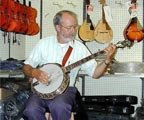South Carolina musician Al Wall passed away this past August.
Wall began playing hillbilly and “old-time” music before it was dubbed
bluegrass. He was one of eleven children in a family he described as not very
musically oriented. As a teen, he cut his teeth during radio-sponsored music
competitions. In 1941, he and his band won an amateur contest that launched his
professional career. Wall served in the Navy during World War II, and
entertained the troops while benefiting from exposure to other musicians. “I
gained great inspiration from my father,” recalled Wall. “The initial learning
process was provided by my neighborhood friends.”
Wall adopted bluegrass, a postwar hybrid of Appalachian vocal and
instrumental traditional music, as his preferred genre before the term was
coined. In 1996, Wall told a reporter from the Charleston Post and Courier, “in
those days, there wasn’t bluegrass and there wasn’t country. It was hillbilly
music.”
A retired dairy industry executive with accounting and economics degrees,
Wall pursued his music in his off-hours. He became a vocal and tireless
supporter of traditional music in South Carolina, writing about bluegrass and
western swing for magazines, and authored two unpublished manuscripts on
bluegrass.
Bluegrass is as uniquely American as blues and jazz. Wall produced “a
laudable celebration of American folk music… I respectfully call my craft
‘America’s blue collar soul music,’ a term which I believe more than adequately
describes the assortment of old country sounds, blended into a single identity.”
Wall played with legends like Pappy Sherrill and Chet Atkins and was a member
of the Rythym Aristocrats, a pioneering old-time country band headed by Fisher
Hendley in the 1930s and 40s. Wall continued to produce western swing, country,
bluegrass and gospel offerings at a variety of venues, including the annual
“Breath of Spring Music Festival” at Cypress Gardens, South Carolina. Wall
received the Jean Laney Harris Folk Heritage Award in 2001.
Monday, October 29, 2012
Wednesday, October 24, 2012
Finally back online.....
Greetings from the Folklife Resource Center (FRC) at McKissick Museum! Finally worked some bugs out of the system and we are now back to the blogoshere. So many projects to talk about, so little time! Let's begin here:
The Folklife program partnered with the South Carolina Arts Commission in 2011 to continue the first county-wide traditional arts survey project conducted in SC. While we have conducted focused fieldwork efforts in counties throughout the state in the past, we have never embarked on a comprehensive, 46 county survey. Exciting! We are meeting an amazing variety of traditions so far - a Burundi Gospel choir, a Cambodian roneat player, Burmese dance and song, white oak basketry - and we've only just begun!
Make sure you visit www.digitaltraditions.net on a regular basis for periodic updates.
The Folklife program partnered with the South Carolina Arts Commission in 2011 to continue the first county-wide traditional arts survey project conducted in SC. While we have conducted focused fieldwork efforts in counties throughout the state in the past, we have never embarked on a comprehensive, 46 county survey. Exciting! We are meeting an amazing variety of traditions so far - a Burundi Gospel choir, a Cambodian roneat player, Burmese dance and song, white oak basketry - and we've only just begun!
 |
| Kiln sale of SC potter Linda Green. 2011 Spartanburg, County. |
Subscribe to:
Comments (Atom)

